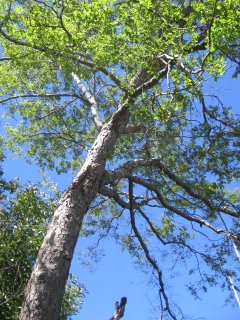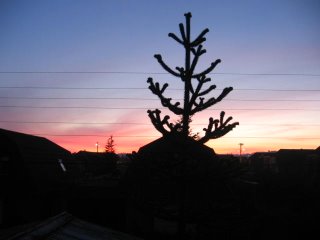
Transportation to Parque Huerquehue can be found in Pucón by microbus every morning for a very modest fee.
Travel writing, tips, and perspectives from an American living in Temuco, Chile.

Transportation to Parque Huerquehue can be found in Pucón by microbus every morning for a very modest fee.
Metropolitan Cathedral
The easiest method of transportation in
The small town of
In the summer Pucón is a very crowded city, and the main beach on
Parque Oncol is a 754 hectare preserve of native Chilean temperate rainforest, and is an excellent day trip to make from
Inside the park there are several trails, one of which reaches several lookout towers that over an amazing view of the Pacific Ocean and

For adventure seekers, the park has an extensive canopy tour, which is the best in the area, and offers a unique way to view the top of the forest.


For those who wish to spend the night in
Puerto Saavedra is a small costal town directly east of
At the start of the peninsula is Cerro Mirador, a very high hill with a lookout tower that offers a panoramic view of the landscape. A short walk or bus ride from Puerto Saavedra is Boca Budi, a small strip of land between the Pacific Ocean and Lago Budi, one of the only saltwater lakes in
If spending the night in Frutillar cabins are by far the best option. During the summer months a full cabin on the beach should cost around $60 to $80 a night, and $40 a night during the rest of the year. Daytime attractions include the beach, water sports, the German Colonial Museum, and German restaurants. No trip to Frutillar is complete without eating Kuchen, a typical German desert.
Unless you are in the northern tip of
For those living in
If staying for longer periods of time, you will probably grow weary of taking this trip, and wish to obtain a visa. You may receive a one year tourist visa with the proper paperwork. It is not difficult to receive, but you must prove that you will not be a financial burden to the country. Copies of bank records showing sufficient funds are helpful, but they may ask you what activities you are doing in



 Monkey Puzzle or Pehuén (Latin: Araucaria araucana, Spanish: Araucaria)
Monkey Puzzle or Pehuén (Latin: Araucaria araucana, Spanish: Araucaria) Chilean Fire Bush (Latin: Embothrium coccineum, Spanish: Notro)
Chilean Fire Bush (Latin: Embothrium coccineum, Spanish: Notro)
If you have never burned firewood for heat before, it may take some getting used to, but it is not without its charm. On a cold winter day, a wood fire will be very cozy, and many find the quality of heat to be superior to gas.
When it comes to buying firewood, there are several options, and not all are equal in value and quality. Firewood is only economical if it is bought in bulk, by the cubic meter. A cubic meter of firewood should cost anywhere from 12,000 to 18,000 pesos ($24 - $36). It will be delivered directly to your house. When buying firewood there are two things to watch out for – dishonest vendors and wet wood. Almost all vendors will try giving you less than a cubic meter, as most people don’t have an exact concept of a cubic meter. To avoid this, have a tape measure and calculator ready. After the vendors stack the wood, measure all three dimensions of the stack, and multiply. An example of a common stacking arrangement is 1.5 meters tall, .3 meters deep, and 2 meters wide. Calculating 1.5 X .3 X 2 gives .9 cubic meters, which is less than you paid for. If this happens, insist on another row, or whatever quantity is necessary to give you 1 cubic meter. You must also watch out for wet wood, as it will give you less heat as well as more air pollution. It is difficult to find properly dry wood, especially towards the end of winter. If you are staying in
If all this sounds like too much hassle, find an apartment with a gas furnace, and expect to pay much more in heating bills.
 Villarrica is a small, somewhat rural community on the shores of Lake Villarrica, a large lake in the Lakes District. It is on the opposite side of the lake as Pucón, a heavy traffic tourist area. Although much smaller than Pucón, it still has much to offer, especially for those desiring a more relaxed and quiet city than Pucón.
Villarrica is a small, somewhat rural community on the shores of Lake Villarrica, a large lake in the Lakes District. It is on the opposite side of the lake as Pucón, a heavy traffic tourist area. Although much smaller than Pucón, it still has much to offer, especially for those desiring a more relaxed and quiet city than Pucón.Although Chile officially gained independence from Spain in April of 1818, the process of gaining independence was started on September 18, 1810, and this day is traditionally celebrated in Chile as Independence Day. The celebration, however, is not confined to the 18th, but to several days before and after.
Typical celebration consists of an asado (barbeque), eating empanadas, dancing cueca, the traditional dance, and drinking wine or chicha. For an authentic celebration, most towns have dances at ramadas, which are open-air thatched roof buildings made of branches, based on traditional Chilean shelters.
 Like the 4th of July in the
Like the 4th of July in the
Chileans are very patriotic, and the spirit of Independence Day is seen all of September. Traditional Chilean music can be heard in stores, and the national colors are displayed. On the 18th nearly everybody displays a flag, which is in fact required by law (although not enforced).

Near the top of the hill there is a well situated restaurant and bar. Because of its secluded location it is usually empty, with the exception of events or festivals. It is always fun to have a beer after hiking up the hill.
Cerro Ñielol is by far the highlight of
 Beautiful Coastline of Mehuin
Beautiful Coastline of Mehuin Seafood Market in Mehuin
Seafood Market in MehuinIn 1960 Mehuin was destroyed by the tsunami that resulted from the 1960 earthquake. It has since been rebuilt, but is now much smaller. Mehuin now faces an equally grave threat - a proposal to build an industrial waste pipeline from a factory of the Chilean industrial giant, the Chilean Pulp Company (Celco). For the last ten years the community has been battling the corporation, which received the approval of the government under Ricardo Lagos. The proposed pipeline would pump waste chemicals at a rate of 900 liters per second directly into the bay, effectively shutting down the fishing industry in Mehuin, and destroying the livelihoods of 400 families.
The members of the fishing community have succesfully blocked previous testing from being accomplished in the bay, but it is inevitable that they will eventually lose the fight. See the following blog for a video of the local fisherment sucessfully shutting down testing by the armed Celco ship. Lake Pellaifa
Lake Pellaifa